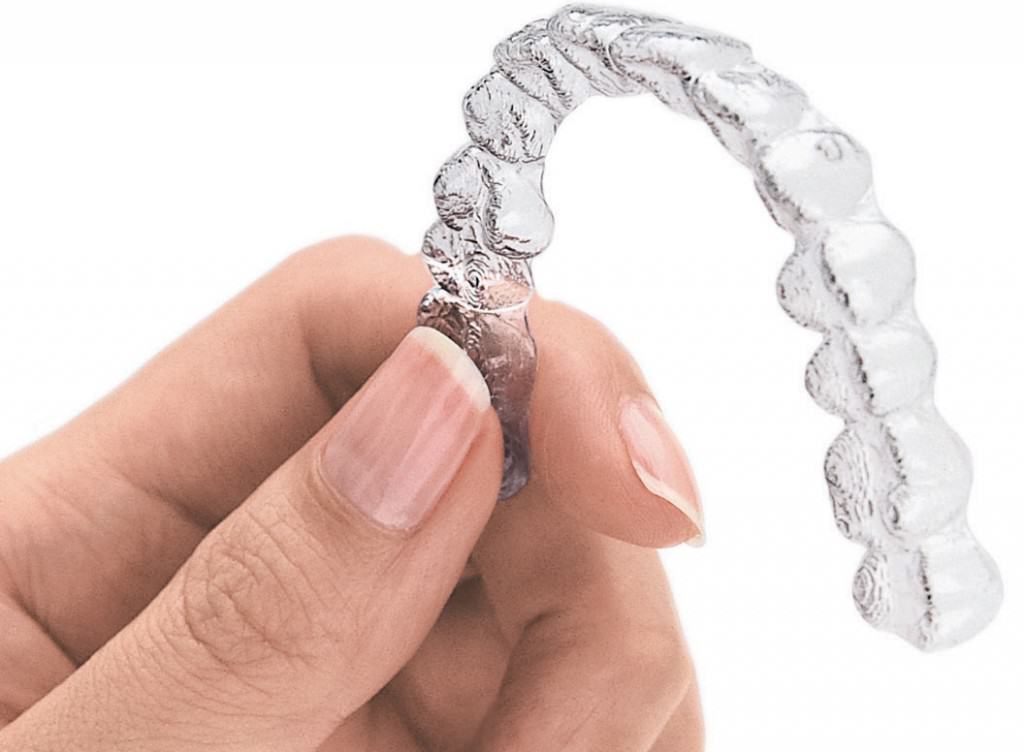If you’re contemplating having your teeth straightened and have been researching options, you’ve probably heard of Invisalign. According to Invisalign’s website, more than 7 million people have used the non-traditional orthodontic device. As a discreet, removable alternative to metal braces, it is very popular with teens and adults. If you’re wondering “can I get Invisalign?”, you first need to understand if it will work for you and if you are able to meet the Invisalign requirements.
What is Invisalign and How Does it Work?
Invisalign is a series of clear plastic devices called trays that slip onto the teeth—one on the top teeth and the other on the bottom. They gently move or turn teeth into the position where they belong for a straight smile.
The process starts with a 3D image of a patient’s teeth. From this image, a plan is devised as to how the teeth will be moved into place. A series of trays is designed with incremental changes to gradually make it happen. The patient wears each set of trays for two weeks for about 22 hours each day before moving on to the next set. With each new set, the teeth travel closer to their final destination.
Invisalign treatment takes on average 9 months to a year, about half the normal time as braces. Patients can start seeing results in as little as two months.
Patients may need attachments called buttons or bite ramps to help the Invisalign trays grip the teeth. These are small, tooth-colored bits of resin that are cemented to teeth and removed once the straightening process is complete. They are meant to blend in with teeth so they aren’t noticeable when the clear aligners are in place.

Why People Love Invisalign
Invisalign trays aren’t invisible, of course, but they are discreet. Those who balk at having metal braces in their mouth appreciate that they can wear clear plastic trays that are hard to see. Adults and teens can wear them as part of their normal daily routine without most people noticing.
Invisalign wearers like that they can remove the trays whenever they want. In fact, they need to come out whenever you eat or drink. Being able to take them out for special social occasions, professional meetings, or photos is a definite advantage.
Unlike braces, there are no wires or metal brackets to cut or poke the inside of the lips. Invisalign trays are smooth. Switching to a new set of trays can put some additional pressure on the teeth. This minor discomfort usually goes away within a day or two.
What Can Invisalign Fix?
Invisalign is meant for teens and adults. Dentists will not recommend it for children who do not have all of their permanent teeth and whose jaws are still growing. Even if a patient is older, Invisalign may not be their best option.
An important thing to consider when asking “can I get Invisalign” is how crooked your teeth are. Invisalign is meant for mild to moderate crowding, crookedness, and gaps. Very pronounced malocclusions (overbites, underbites, or crossbites) have better luck with braces.
Many people who had braces as a kid notice that their teeth don’t stay straight forever. Their teeth may be fairly straight, but have shifted over time. Invisalign might be a good option to restore the alignment they had decades ago.
It’s important to note that teeth can shift, even after Invisalign. There are many reasons why teeth might shift; fortunately, there are also things you can do about it. For example, in many cases, retainers are used for an extended period of time to keep the desired alignment.
A dentist who is experienced with Invisalign is the best judge of how well Invisalign will work and how long it will take.

Living With Invisalign
Can you get Invisalign? Yes—if you can commit to the process. If patients don’t follow the Invisalign requirements, treatment will take longer than expected, or won’t get the desired results. Here are the things that Invisalign users must do:
- Keep Invisalign trays in for 20-22 hours each day. Because the trays are so easy to remove, this takes a certain level of self-discipline.
- Follow the Invisalign plan for switching to new trays. Trays are usually worn for two weeks before trading them in for the next set in the series. Forgetting to switch on time, or skipping a set can interfere with the straightening plan and delay progress.
- Do not eat or drink with Invisalign trays in the mouth. Food particles and liquid can be trapped between teeth and trays, which can cause tooth decay. And chewing and biting can damage or break Invisalign. Failing to remove trays can cause cavities or damage Invisalign. The exception is water and products like Movemints, which not only freshen breath but help to “seat” the trays on the teeth.
- Take care of the trays. Since you do need to take the trays out to eat, losing them or setting them down on dirty surfaces is a possibility. Keep a carrying case on hand and clean them properly to avoid problems.
- Keep regular dental appointments. Follow the dentist’s instructions for checkups. They will typically want to check on the treatment’s progress every 4-6 weeks.
What You Will Pay for Invisalign
There is personal responsibility necessary for getting Invisalign, and there is also a significant financial investment. Invisalign treatment costs between $2500 and $7000. This is a bit less than traditional braces which are around $2000 to $6000.
Many people feel that the convenience and aesthetics of clear aligner trays are worth the extra money. On the other hand, for people without the discipline necessary to follow the Invisalign requirements the extra expense will be a waste.
Payment options for Invisalign and braces are similar. If the teeth straightening is necessary for the patient’s oral health rather than simply cosmetic, insurance may cover at least some of the cost. If the patient has to pay out-of-pocket, many dentists offer payment plans. They may also use flexible spending accounts (FSA), or dental credit cards. We reviewed all of the options in “Covering the Cost of Invisalign.”
Where to Get Invisalign
Another great thing about Invisalign is that you don’t need to find an orthodontist to get them. Many dentists are equipped to offer them. To find an Invisalign specialist near you, first, decide if following the rules of wearing them will work for your lifestyle. Then, book an appointment for a consultation with a dentist who specializes in Invisalign.
Invisalign is a brand name, and there are other alignment products on the market. It is important to do your research before choosing. Remember to look for the best value, rather than focusing only on cost. Be cautious of do-it-yourself methods of teeth straightening. With some of them, there is no interaction with an actual dentist. Products like Invisalign include a dentist’s supervision and typically have better results. Hopefully, we have helped you answer the question “can I get Invisalign?” If the answer is “yes!” and you’re ready to find a dentist who provides it, you can start with our online search tool.


